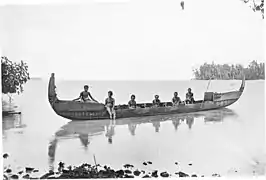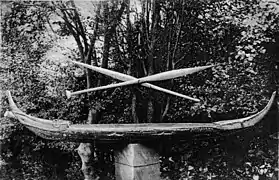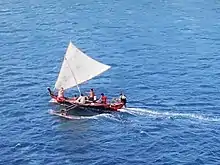Lisi is a type of plank boat from the Solomon Islands. It is crescent-shaped and is similar in appearance to the tomako war canoes, but differs in that the topmost strakes of the lisi have a gap in the middle.[1] Lisi are also usually proportionally broader and less ornamented than the tomako. They are used for fishing and transport rather than for raiding. Lisi can vary in size from small canoes to large ships used for trade.[2] The largest types of lisi are known as solima, which can carry 50 people and is used for long sea voyages.[3] There are two general types of lisi, the ordinary trading lisi is known as the "lisi nume." An ornate lisi with inlaid shell decorations used for transporting village chiefs in diplomatic missions is known as the "la'o." Voyages of lisi to other islands usually required a ritual human sacrifice on the return trip known as siki po'upo'u ("removing the cross sticks").[4]
Gallery
 Model of a lisi with a bird-shaped prow in the Vatican Museum
Model of a lisi with a bird-shaped prow in the Vatican Museum A lisi from Marau Sound (c. 1908)
A lisi from Marau Sound (c. 1908)_BHL15849751.jpg.webp) Illustrations of lisi from Voyage de La Pérouse autour du monde (1792)
Illustrations of lisi from Voyage de La Pérouse autour du monde (1792) Model of a lisi from Makira (c. 1887)
Model of a lisi from Makira (c. 1887).jpg.webp) A lisi with painted designs from Malaita (c. 1909)
A lisi with painted designs from Malaita (c. 1909)
See also
References
- ↑ Holtzman, Bob (2016-12-27). "A Solomon Islands Canoe at the Vatican". Indigenous Boats - Small Craft Outside the Western Tradition. Retrieved 11 November 2019.
- ↑ Woodford, C. M. (July 1909). "The Canoes of the British Solomon Islands". The Journal of the Royal Anthropological Institute of Great Britain and Ireland. 39: 506–516. doi:10.2307/2843216. JSTOR 2843216.
- ↑ Haddon, Alfred Cort; Hornell, James (1937). Canoes of Oceania: The canoes of Melanesia, Queensland, and New Guinea. Bernice P. Bishop Museum. pp. 88–89.
- ↑ Ivens, Walter George (2018). Revival: Melanesians of the South-East Solomon Islands (1927). Routledge. ISBN 9781351338882.




